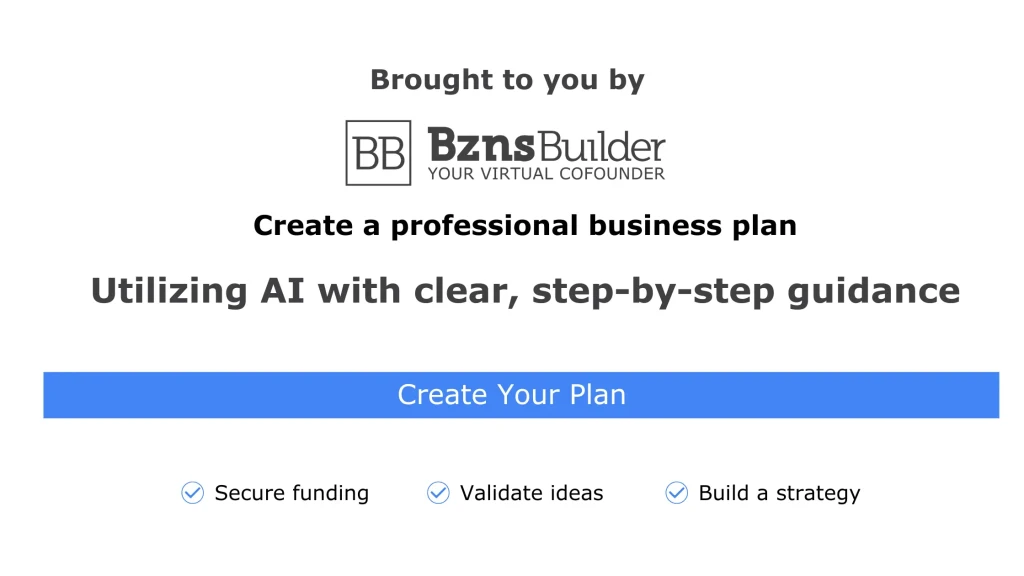Understanding Business Strategy: What It Is and How to Build One

Growing your business opens up a world of possibilities. You might consider forming strategic partnerships to expand your market reach, enhancing your product with innovative features that solve customer pain points, or diversifying your offerings with new products and services tailored to emerging trends. These ideas promise growth and success, but they can also feel overwhelming due to their sheer number.
Despite the allure of endless opportunities, your time, budget, and resources are finite. Investing in the wrong initiatives can drain valuable resources and hinder your business’s progress. Understanding which paths to prioritize is crucial for sustainable growth and long-term success.
This is where a well-defined business strategy becomes indispensable. A business strategy serves as your roadmap, aligning your goals with actionable steps and ensuring that every decision you make contributes to your overarching vision. By focusing on clarity and direction, a robust strategy empowers you to channel your resources effectively and avoid costly missteps.
What is a Business Strategy?
A business strategy outlines what makes your business unique and how you’ll solve a specific problem for your customers. It helps you focus on creating value to solidify a competitive advantage in the market and reach your goals.
Creating a business strategy gives you a guide for making decisions that prioritize growth. A few use cases for your strategy include:
-
Entering a new market
-
Launching a product
-
Repositioning your business
-
Allocating resources
-
Addressing business challenges
Why is a Business Strategy Important?
A good business strategy helps you:
Maintain Focus
With a business strategy in place, you’ll be better prepared to avoid chasing every new opportunity. It helps channel your efforts toward opportunities that align with your objectives.
Avoid Wasting Resources
Without a well-thought-out strategy, there’s a higher risk of wasting time and money, possibly leading to business failure.
Keep Your Team Aligned
A clear strategy keeps you and your team on the same page. It guides your collective focus towards specific business goals and ensures everyone moves in the right direction.
Attract Investment
Investors need to see how you solve a problem in a way that differs from the competition. Your strategy explains that and shows how you’ll execute on your idea.
Stay Competitive
Your business strategy doesn’t just take your customers into account—it also forces you to understand your competitors. You’ll understand how you compare and what it will take to grow beyond them.
How to Create a Business Strategy
When developing a strategy, keep it simple. Focus on the needs of your customers and the value of your business. Here’s how:
Tip: Download our free one-page business plan template. It provides a simple but effective format to document your business strategy.
- Know Your Customers
You shouldn’t take action without understanding your customers’ needs. Read reviews, conduct surveys, dig into forums, and—most importantly—talk to your customers.Whatever you do, collect real-world data and develop an understanding of your target market.
Now, you need to document your results. Add enough information for you, and anyone else, to easily understand:
-
Who your target customers are
-
How many potential customers there are
-
Specific preferences like buying habits, cultural affinities, etc. Don’t go into too much detail here. Just have enough information to paint a picture of your ideal customer.
What if You’re an Up-and-Running Business?
If you have created a business plan, you should already have a profile of your target market. For this step, revisit your information and determine if it is still relevant and accurate.Tip: You may find it valuable to craft a customer persona—a faux customer profile based on your market research. It’s a helpful tool to visualize your customers and keep them top of mind.
-
- Define Your Value Proposition
The crux of your strategy is the distinct value your business provides. The research and information you’ve documented will make defining that value much easier. By the end of this step, you will have brief descriptions of:-
The problem you solve
-
Your solution
-
Your value proposition
These will be brief but powerful statements for your business. It’s where you define what you do, why, and how you do it better. They’ll drive your strategy and help turn your customers’ needs into memorable statements that you, your employees, and even potential investors will focus on.
Tip: If you’ve written a business plan, you don’t have to start this process from scratch. You likely already have the components or even entirely written statements in your Products and Services and Sales and Marketing sections to use.
Describing the Problem
In a sentence or two, outline the critical problem your target customers face.Example: “Many urban professionals in the region struggle to find fresh, locally sourced ingredients for daily cooking that cater to diverse culinary traditions.”
Explaining Your Solution
Briefly describe how your product or service addresses the problem identified.Example: “Our platform connects urban households with local farmers and artisanal producers, delivering fresh, high-quality ingredients tailored to regional cuisines.”
Creating Your Value Proposition
Your value proposition is a clear, concise statement explaining:-
The unique benefits your products or services provide
-
Who you provide them to
-
How they are different or better than similar offerings in the market
You can use your descriptions of the problem and solution to help define the key product/service benefits in your value proposition.
List what factors set you apart from the competition. Hone in on a theme for both that resonates with your customer’s needs and preferences. Then, combine these ideas into a single sentence.
Example: For a regional food delivery platform focused on quality and cultural relevance, your value proposition might look like:
“Experience fresh, locally sourced ingredients delivered to your doorstep, celebrating the culinary heritage of the EMEA region.”
-
- Analyze Your Competitors
Understanding your competition is crucial for carving out your unique space in the market. Here’s what to look for:- List Your Competitors: Identify the main players in your market.
- Evaluate Their Offerings: Examine their products or services. Try to spot differences in product features, pricing, customer service, or brand perception.
- Assess Their Value Proposition: Understand how they position themselves, the unique value they claim to offer, and how they communicate this to customers.
- Understand What Customers Think: Look at customer reviews, testimonials, and social media feedback to gauge customer satisfaction and common pain points.
Like your customer research, you don’t need to be overly detailed here. You want a simple summary of the competition and why you’re different or better than them. That should provide enough information to help with the final step.
Example: After checking out the competition, you realize that your food delivery platform offers far more options tailored to local tastes and dietary preferences, such as halal-certified meals and vegan options. Additionally, your focus on fast delivery and exceptional customer support stands out in a crowded market.
What if Your Business Provides a Solution Similar to Competitors?
If this sounds like you, then you’ll need to focus your differentiation efforts on:-
Where the product/service is sold
-
Messaging and marketing channels
-
How your business makes money
All of which we’ll cover over the next three steps.
- List Your Sales Channels
The sales channels you choose and prioritize should be based on the needs of your target customers.- Where do they expect products/services like yours to be?
- Where do your competitors sell theirs?
- Are there untapped sales opportunities that would better serve your customers?
Focus on that last question if you’re trying to differentiate through your sales efforts. The biggest opportunity may simply be to better serve the purchasing habits of customers instead of offering a fully unique solution.
Example: Let’s revisit our platform and assume you plan to offer your service through a mobile app. That’s one sales channel—customers place orders directly through the app. Your competitors also do that, but your app offers seamless language options and integrates with local payment systems like M-Pesa or Fawry, making it more accessible.
Additionally, you partner with local supermarkets to allow customers to pick up their orders—a convenient option for those who prefer in-store experiences. These efforts, combined with a user-friendly website, give you a strong multichannel presence.
Sales Channels
-
Mobile app
-
Website
-
Local supermarket partnerships
-
Catering for events
-
Direct-to-business delivery
- Explain Your Marketing Activities
How will you spread the word about your business?-
Will you take out traditional ads in newspapers and on billboards?
-
Focus on paid advertising through Google search or Facebook?
-
Maybe branch out and partner with influencers?
Whatever you choose, focus on marketing activities that get you in front of your customers. There’s no reason to invest money in places where your customers aren’t spending their time. If you do, you’ll struggle to see any real return on marketing efforts.
Now, that doesn’t mean you just replicate what your competitors are doing and do the same marketing activities. They may not be the most effective or targeted efforts. In fact, by taking a different approach, you could differentiate your business through the channels and messaging you choose.
Example: You notice that most of your competitors’ marketing consists of billboards and flyers. They don’t engage customers through social media or local community events.
You believe that your target customers value a more connected and socially conscious approach. So, you create campaigns that feature local influencers showcasing how your services fit into their everyday lives. You also sponsor local food festivals and partner with nonprofits focused on food sustainability, creating goodwill while boosting brand awareness.
This approach, compared to your competitors, is far more interconnected. Each effort promotes and bolsters the rest—potentially leading to more consistent messaging and cost-effective creation.
Read More: How to Create a Zero-Waste Business Strategy
-
- Describe Your Business Model
Your business model describes how your business will make money—covering where revenue comes from and your expenses.But, did you know that your strategy can be focused on innovating with your business model?
You don’t need to invent a fully new business model either. Instead, focus on identifying ways to optimize:
-
The creation of your product/service
-
How you sell your product/service
-
How and what your customers pay
Example: You’re not trying to break the mold with how you make money through your food delivery service. However, you have identified a few ways to make your business model more profitable.
First, you’ve partnered with regional farmers to source fresh produce, reducing logistics costs and improving product quality. Additionally, you’ve expanded your payment options to include regional digital wallets and cash-on-delivery services, making transactions more convenient for customers.
You’ve also introduced tiered delivery pricing based on urgency. Customers can choose between standard delivery or express options, allowing for increased revenue flexibility.
If you’re just putting your strategy together, don’t focus on going too in-depth with your number crunching. Instead, describe your business model by simply listing your revenue streams and key expenses.
Once you have a business model that you believe will work (and have ideally tested it with customers) then create detailed forecasts to make it usable.
Tip: Check out the financial plan step in our business planning guide for in-depth guidance on creating financial forecasts.
-
How to Execute Your Business Strategy
Creating a business-level strategy is a significant step, but making that strategy actionable requires careful planning and execution.
Define Your Tactics
Transitioning your business strategy into functional tactics is essential for achieving your goals. While your strategy sets the direction, tactics detail the operational steps and daily activities necessary to bring that strategy to life.
Example: If your differentiation strategy is to reduce delivery times significantly, your tactics could include optimizing delivery routes using advanced mapping software or partnering with local logistics companies to streamline distribution. Additionally, introducing a customer notification system that updates clients on their delivery status in real-time could enhance satisfaction and transparency.
For successful implementation, each tactic should have:
- Clear deadlines: Set specific timelines for achieving milestones.
- Identified bottlenecks: Recognize and address potential obstacles early.
- Process adjustments: Continuously refine your approach based on feedback and results.
Every tactic should align with your long-term strategic goals. If certain tasks or activities don’t contribute to the broader vision, reconsider their priority in your plan. Aligning work with your strategy ensures a focused and efficient path to success.
Measure Performance
The entire point of developing a strategy is to ensure you are making progress toward the growth of your business. Even if you’ve worked through all of the steps we’ve outlined here, you will struggle to make any real progress without tracking and evaluating your performance.
Choose the Right Metrics
The metrics or key performance indicators (KPIs) you focus on measuring fully depend on your strategy. Start with fundamental metrics like revenue growth and cash flow to understand the overall health of your business. From there, refine your KPIs based on specific strategic goals.
Example 1: If your focus is expanding into new markets, measure metrics such as market penetration rate and customer acquisition cost (CAC). These indicators show how effectively you’re attracting and converting new customers in a given region.
Example 2: If enhancing customer loyalty is your goal, track retention rates, repeat purchase rates, and the Net Promoter Score (NPS). These metrics help you assess satisfaction and long-term customer engagement.
Establish a Tracking System
Set up tools and systems for collecting and analyzing performance data. Consider using customer relationship management (CRM) software, financial dashboards, or specialized analytics platforms to streamline tracking and reporting.
Regular Reviews and Adjustments
Regularly review your KPIs to evaluate progress and identify areas that need improvement. Establish a cadence for performance reviews—whether monthly or quarterly—and adjust your tactics as necessary to stay aligned with your strategy. Delayed insights can lead to missed opportunities, so staying proactive is key.
Tracking performance metrics ensures your strategy remains dynamic and responsive to changing business environments, enabling consistent growth and success.
Bring in Your Team
Engaging key stakeholders early provides unique insights that can lead to a more well-rounded strategy. It also helps foster a sense of ownership and trust between you and your employees.
Collaborate Strategically
While it may not be necessary to share your strategy with everyone during the early stages, collaborating with the right individuals can streamline efforts. By involving team members who understand your business’s core functions, you can:
-
Identify potential challenges before they arise.
-
Generate innovative ideas for applying the strategy across departments.
-
Ensure alignment between individual, team, and organizational goals.
Example: If your goal is to expand into a new region, include representatives from your sales, marketing, and operations teams. Their on-the-ground insights can reveal market-specific opportunities and challenges you might not have considered.
Foster Ownership
Including stakeholders in the strategic process builds trust and a sense of ownership. Employees are more likely to be committed to executing a plan they helped shape. Use collaborative tools like brainstorming sessions, workshops, or strategy meetings to involve them meaningfully.
Streamline Application
Bringing in your team early also allows for a smoother implementation of the strategy. Discussions can lead to actionable steps for smaller projects, ensuring that the overarching goals are broken down into manageable, aligned objectives.
Engaging your team creates a unified approach that not only strengthens the strategy but also increases the likelihood of its successful execution.
What Makes a Successful Business Strategy?
Your strategy won’t be perfect. Even if you follow these steps to the letter, unforeseen circumstances, changes in the market, or any number of things will force you to adjust.
Stay Adaptable
Successful strategies are flexible. Build mechanisms into your planning process for revisiting and revising your strategy regularly. Consider quarterly reviews or pivot points tied to major milestones.
Use the Right Tools
Documenting and reviewing your strategy becomes easier with the right tools. This is where BznsBuilder excels. BznsBuilder offers a comprehensive suite of features to help businesses:
- Develop Detailed Business Plans: Create and customize a professional business plan with intuitive templates and guidance.
- Track Key Metrics: Use built-in analytics to monitor revenue, cash flow, and other KPIs critical to your business strategy.
- Collaborate Effectively: Share your strategy and business plan with your team or stakeholders in real-time, fostering collaboration and alignment.
- Adjust Dynamically: Regularly update your business plan and strategy with BznsBuilder’s cloud-based tools, ensuring it evolves with your goals and market conditions.
By leveraging BznsBuilder, you can ensure your business strategy remains actionable, adaptable, and aligned with your objectives.
Staying proactive and open to change will ensure your business strategy evolves with your organization, keeping it relevant and effective in achieving your objectives.








